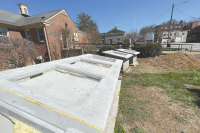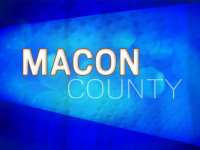One façade at a time: Cherokee makes over downtown appeal
Cherokee is on a mission to remodel the look of its business district, in the hope that an infusion of native-themed architecture can give new life to its outdated commercial appearance.
“We want it to be pleasing to the eye of the visitor,” said Jason Lambert, the tribe’s economic development director. “We want it to be an area that is a point of pride for the local community and reflects who we are.”
A plan to makeover its tourist appeal has been in the works for 10 years. While some businesses have embraced the idea and jumped on board with Cherokee’s new look, challenges remain. Cherokee is struggling to persuade some building owners and businesses to take on the expense of remodeling because of complex landownership issues and difficulties quantifying the changes’ effects. As a result, pockets of out-dated, run-down facades can still be found along the downtown strip.
The tribe hoped that business owners would see the appearance changes and think, “‘If I don’t improve, then I’m not keeping up,’” said Michell Hicks, principal chief of the Eastern Band of Cherokee Indians.
Hicks admitted to being “frustrated with some of the downtown.”
“We don’t keep updated enough when it comes to businesses,” he said.
Related Items
Leaving a legacy
Nonetheless, steady progress has been made to improve the appeal of downtown since the tribe first adopted a master plan dating to 2001, which laid out a uniform appearance for buildings throughout the central business district. The guidelines focused on drawing attention to the town’s natural surroundings and Cherokee architecture by incorporating river walks, heavy timbers, native stone work, earth tones and green, metal roofing and Cherokee lettering.
The development of river walks and greenways particularly are aimed at getting visitors to linger in the area.
“We’re a fast moving society; we’re a fast food society. And so, if we can slow people down and get them out, then that’s accomplished our aim,” Lambert said. “The thought process there is of course that the longer people stay the more likely they are to engage in commerce and spend money.”
Although the recommendations were not mandatory, Cherokee tribal leaders hoped business owners would make the appearance changes on their own.
However, from 2001 to 2006, “Not much was done,” Lambert said. “So the tribe tried to put the first foot forward.”
As a model of Cherokee’s “new look,” the tribe decided to renovate a few buildings of its own in the downtown district that are leased to businesses. The tribe spent $4 million revamping the collection of storefronts known as the horseshoe, a price tag that included the river walk behind the buildings among other improvements.
Meanwhile, the tribe also set up a fund to offer loans with 1 percent interest rates to businesses interested in refurbishing their look.
“The tribe said we will do ours and make low-interest loans available to the other business owners,” Lambert said.
The Eastern Band of Cherokee Indians has also paid for other, less-apparent appearance alterations. The utility lines through the main thoroughfare in Cherokee were moved underground, new streetlights were added and more than 20 painted bear statues decorate the town.
“I think actually we’ve made a lot of progress,” Hicks said.
However, he would like to see more changes during the next three or four years.
“We definitely have a lot more work to do, especially with our signage,” said Hicks, who views the improvements as part of his legacy as chief.
After redoing the downtown area, Cherokee leaders decided to extend the new look beyond the central business district to other commercial areas.
The focus is now on the business strip just past the Cherokee Indian Fairgrounds on U.S. 441, which will soon see culturally themed streetlights, underground utilities, new and wider sidewalks, crosswalks stamped with cultural symbols, improved landscaping and signage, and the addition of benches, bike racks and recycling bins.
The tribe has received money from the Cherokee Preservation Foundation to fund its downtown improvements over the years.
Last fall, the tribe got a $1.8 million grant from the foundation to fund appearance improvements on the new stretch of U.S. 441.
Previously, the foundation gave $2.5 million for downtown improvements — about $1.3 million to remodel buildings in the horseshoe and the $1 million for the low-interest business loans.
The preservation foundation has been “a very integral part” of completing phases of the project, Hicks said. The foundation makes annual grants using a cut of casino proceeds.
Embracing cultural themes
Tribal Grounds coffee shop is one of about eight businesses that moved into the remodeled horseshoe in Cherokee’s downtown.
The coffee shop moved from its old location across from the Museum of the Cherokee Indian and began leasing one of the storefronts that were remodeled by the tribe.
“It also works perfect for our purpose,” said Emily Gisler, a manager at Tribal Grounds.
“People seem to like it,” added Jennifer Welch, also a manager at Tribal Grounds.
The push for a more uniform storefront appearance is part of the tribe’s effort to make the Cherokee reservation a destination rather than a one-day excursion.
However, some would rather keep their “unique fronts,” Gisler said. And although the newer look gels more with the Cherokee culture, “a lot of tourists like to see things they are familiar with,” she said.
Some businesses are already housed in buildings that fall in line with the tribe’s appearance recommendations, including the use of wood, earth tones and metal roofing.
“I take care of my own store just to keep my customers,” said Tim Marks, owner of Ravenhawk Gifts and Collectibles.
“It’s worth it to us to hear people come in and tell us the store looks nice,” chimed in his wife, Lorie Marks.
Other Cherokee business owners chose not to change or felt the help came too late.
“We just chose not to,” said Maureen Denman, who has run Heavenly Fudge Shoppe in Cherokee with her husband for 35 years. “I don’t have extra money to do that.”
The couple already has a loan on its business and didn’t need another. They would have considered taking such a deal if it had come sooner.
The tribe is about “20 years too late,” Denman said.
Only 10 businesses accepted low-interest loans from the Eastern Band of Cherokee Indians for building and façade improvements.
The tribe set aside $1 million for the loan program — equaling out to about $100,000 per business. The $1 million pool of funds is now dried up, Lambert said.
“Difference of opinion or lack of interest” has caused some businesses or landowners to forego the redesign, he said. But, the biggest challenge is landownership.
“A lot of the struggle comes from the complicated landownership issues,” Lambert said.
Some building owners do not want to renovate and the business owners who rent their store space do not want to sink money into a place they do not own.
The tribe is currently looking into ways it could quantify the effects of the appearance improvements and show that business has increased at stores with the more culturally focused façades. One option is to look at the tribal levy, Cherokee’s version of a sales tax.
Cherokee has seen a “slight increase” in levy revenue during the past few years, Hicks said.
Although the tribe can’t show a direct correlation between the appearance changes and the number of visitors to Cherokee, the tribe can at least say whether it is seeing more or fewer visitors each year.
“It is difficult to quantify the impact,” Lambert said.
Tribe hopes to diversify attractions
Along with remaking Cherokee’s downtown image, the tribe has launched an aggressive campaign to bring new amenities and attractions in hopes of increasing tourism traffic.
The tribe has already built a new movie theater, skate park and greenway system, and is looking for more ways to sell the reservation as a family vacation destination, such as a water park.
“The water park idea is not off the table,” Chief Michell Hicks said. “It’s the price tag.”
Constructing such a park would be a multi-million dollar project. The casino is a big draw for the 21 and up crowd, but the reservation wants make Cherokee more appealing to families.
Another idea is to build a children’s discovery center where kids could learn about the Cherokee culture and Western North Carolina, Hicks said.
There is also a push to recruit new retail offerings.
“It’s time to start looking at boutique shops,” said Hicks, citing Mast General Store as a prime example of the type of shops he would like to see in Cherokee.
The changes have all been aimed at reminding visitors that there is more to the reservation than the casino.
“We know that the casino is our main attraction, but we want people to know that there is still Cherokee here,” said Jason Lambert, the tribe’s economic development director.
A few business owners said that the casino actually hurts their stores.
Harrah’s Casino pulls visitors’ money away from local businesses, said Maureen Denman, who runs Heavenly Fudge Shoppe in Cherokee. Some people gamble their funds away and have no money to spare at Cherokee’s other establishments.
Part of the future improvements will include drawing events to the downtown area, reconfiguring its parking and generating foot traffic. However, creating foot traffic is pretty much impossible without sidewalks.
Currently, the main business district considered “downtown Cherokee” doesn’t have cohesive sidewalks for strolling. The tribe must decide whether to sacrifice a single row of parking in front of stores to build a continuous sidewalk that runs through downtown Cherokee.
Lambert said the tribe has not decided yet, but will have to address the topic of downtown parking first. There is not enough parking in downtown Cherokee, he said, and the tribe will consider alternative parking solutions such as a park-and-ride depot or a parking garage.
Just because the tribe has shifted its focus does not mean that it will still pushing for renovations to store facades and may offer another round of financial incentives to help.
“We still want to revitalize the downtown,” he said.









